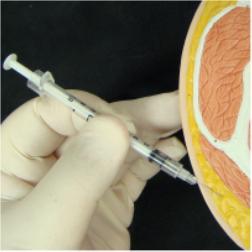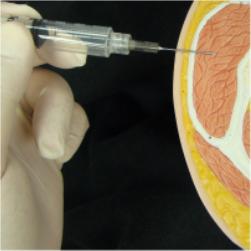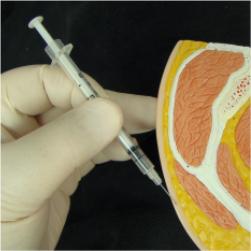This is the Archived Desktop Edition.
You should be transferred to the Newest Edition for Desktop and Mobile within 2 seconds.
Section II. ADMINISTRATION OF MEDICATIONS
1-7. STERILE INJECTION OF MEDICATIONS
A needle and syringe are used to introduce a suitable liquid preparation of a drug(s) directly into the body tissues or veins. A sterile injection of medication is used:
a. When rapid action by the drug is desired.
b. When the drug might be destroyed by digestive juices or vomited if given by mouth.
c. When the patient is unconscious or injured so that he cannot be given the medication by mouth.
d. When local skin areas need to be anesthetized for an operative procedure.
e. When the medication has to be concentrated in a specific area of the body.
Commonly included among the injection methods of drug administration are subcutaneous (beneath the skin), intramuscular (within the substance of the muscle), and intradermal (within the dermis). These injection methods are also referred to as parenteral (other than through the intestine). Because of the accuracy of these methods of administration, these injections provide the patient with a more precise amount of drug and a more rapid onset of drug action. These procedures will be discussed in more detail later in this subcourse.
a. Subcutaneous (Hypodermic) Injection. The drug is injected by syringe and needle into the tissues just beneath the skin. A preparation for subcutaneous use must be a sterile liquid capable of complete absorption or it will irritate the tissues. Although the subcutaneous injection may be given in almost any area of the body, the usual sites are the lateral (outer) aspect of the upper arms and the anterior (front) surface of the thighs.
b. Intramuscular Injection. The drug is injected into a muscle, usually in the buttocks, sometimes in the upper arm or the thigh. The needle is inserted at a 90 degree angle to the skin, through the skin and subcutaneous tissue into the underlying muscle.
c. Intradermal Injection. The drug is injected into the upper layers of the skin, rather than under the skin as in a subcutaneous injection. Minute amounts (0.1 ml) and less are given intradermally, usually to test for drug sensitivity before administering larger amounts by other methods. The medial (inner) surface of the forearm is the site most frequently used.
1-9. CONTROL OF NEEDLES AND SYRINGES
Needles and syringes are controlled IAW local SOP.
Patient safety is a critical factor. You must learn how to administer medications correctly. Wrong injections of some medications may seriously harm or kill a patient. Aseptic technique must be strictly maintained during the preparation and administration of a drug. Failure to do so could result in the introduction of foreign particles or other types of contamination directly into the body. Infection may be introduced through the needle puncture in the skin, and irreparable damage to a major nerve or other structure may occur due to improper technique or a dull needle.
1-11. INSTRUMENTS USED TO ADMINISTER A PARENTERAL INJECTION
Administering medicine by injection requires needles and syringes that are sterile, accurate in measuring dosages, and convenient to use. Using the correct equipment for injection will minimize discomfort or danger to the patient. Figure 1-1 illustrates a disposable rigid plastic container and a disposable needle and syringe.
a. The needle is a tube with a cutting edge that punctures beneath the protective area of the skin. It is made of steel or other metal and is generally disposable. The parts of a needle consist of a lumen (cavity through which medication flows), bevel (slanted tip/cutting edge), hub, and cannula (shaft) (see figure 1-2). The needle comes in standard lengths from one-half inch to six inches (see figure 1-3). The length is determined by measuring from the tip of the point to the junction of the shaft. The choice of length depends on the route ordered for administration. The choice of needle gauge depends upon the thickness (viscosity) of the medication. The gauge is indicated by numbers 14 to 27. The higher the gauge (size) number, the smaller the diameter of the needle. A small gauge is needed for viscous medications; a large gauge is needed for "thin" or watery medications.
b. The syringe is the instrument used for injecting liquids. It consists of a barrel, plunger, and needle adapter that attaches to the needle (see figure 1-4). The plunger pushes the medication through the barrel into the needle. The barrel is marked in cubic centimeters/ milliliters (cc/ml). Syringes come in different sizes
Figure 1-1. Disposable needle, syringe, and container.
Figure 1-2. Parts of a needle.
Figure 1-3. Examples of needles
Figure 1-4. Examples of syringes.
The Brookside Associates Medical Education Division is dedicated to the development and dissemination of medical information that may be useful to medical professionals and those in training to become medical professionals. This website is privately-held and not connected to any governmental agency. The views expressed here are those of the authors, and unless otherwise noted, do not necessarily reflect the views of the Brookside Associates, Ltd., any governmental or private organizations. All writings, discussions, and publications on this website are unclassified.
© 2007, 2014 Medical Education Division, Brookside Associates, Ltd. All rights reserved






